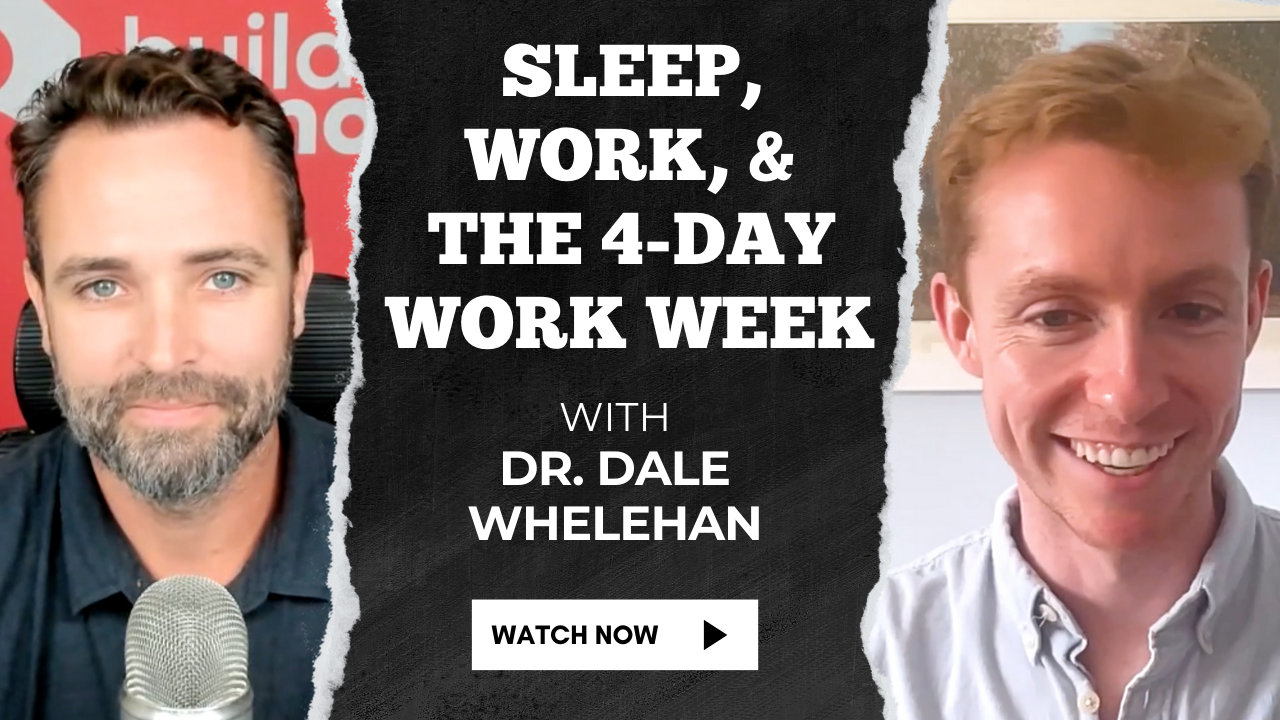Sleep, Work, & The 4-Day Week With Dr. Dale Whelehan [VIDEO]
I’m joined today by Dr. Dale Whelehan who is the CEO at 4 Day Week Global. Dale is also a lecturer at the Graduate business school of University College Dublin and the founder of BehaviorDoc. Early in his career, Dale completed a PhD in behavior science focusing on the impact of sleep deprivation and fatigue on surgeons.
4 Day Week Global is a non-profit that was recently named one of the world’s 100 most influential companies by Time Magazine. Anytime you read about a trial of the four-day work week, 4 Day Week Global is usually the one facilitating it, if not all of the time.
Interview With 4 Day Week Global CEO, Dr. Dale Whelehan
Below, you’ll find some key takeaways that Dr. Dale Whelehan shared in answering each question. The takeaways were created by ChatGPT based on the written transcript of the interview.
- How does the lack of sleep impact work?
- Has anything changed with working hours in the medical field?
- Is is there a point in a block of work time in which your cognitive ability declines?
- What is your work and life like now that you work a four-day week?
- How do companies make the change culturally from hours to output and quality of work?
- What are the characteristics of the company leaders who want to pilot a four-day week?
- How do companies trial the four-day week?
- What percentage of companies permanently implement the four-day week, and why?
- What else changes besides the work hours when a company switches to a four day work week?
- Final thoughts
How does the lack of sleep impact work?
Historical Context:
- Surgical professions have a history of working long hours with little sleep.
- Halstead, pivotal in surgical training, unknowingly set a standard influenced by his reliance on drugs.
Modern Implications:
- Many professions now rely on stimulants and have ineffective stress management.
Cognitive Impact of Sleep Deprivation:
- Reduced attention and vigilance.
- Prefrontal cortex, responsible for higher-order thinking, becomes less active.
- Workers tend to have a tunnel-visioned approach, limiting creativity and complex decision-making.
Emotional Impact:
- Impaired emotional regulation.
- Increased likelihood of conflicts at work.
- Reduced collaboration and teamwork effectiveness.
Has anything changed with working hours in the medical field?
24-Hour Work Program:
- Still prevalent in many medical programs worldwide.
- Medical profession often deviates from standard working hour regulations.
European Union:
- Introduced the “European Working Time Directive” mandating a max of 48 working hours over a month.
- Medical profession, however, received exceptions to this regulation for years.
United States:
- The Accreditation Council for Graduate Medical Education (often referenced as “the economy for graduate medical education” in the answer) sets a max of 80 working hours per week for doctors.
- Many doctors in the U.S. exceed this limit.
Underlying Factors:
- 24-hour work model deeply rooted in the medical profession’s culture.
- Intense competition for specialties and training positions.
- Increased pressure on young staff to work long hours to meet procedural training requirements and climb the ranks.
- Cultural norms within medicine make the 24-hour on-call model less alarming than it might be in other industries.
Is is there a point in a block of work time in which your cognitive ability declines?
Optimal Work Duration:
- Human performance and productivity peak at about 2.5 to 3.5 hours per day.
- Performance starts to decline after this period.
Traditional Work Day:
- An 8-hour workday may not be as productive as commonly believed based on the above finding.
Purpose in Work:
- Work provides many individuals with a sense of purpose.
- People need about 8 hours of work per week to feel purposeful.
- This sense of purpose stabilizes up to 30-32 hours per week.
Excessive Work:
- Beyond 32 hours, work can negatively impact other areas of human performance.
- Overwork can lead to increased fatigue, and when people are time-poor, they may engage in self-destructive behaviors affecting their mental and physical health.
What is your work and life like now that you work a four-day week?
Benefits and Personal Experience:
- Emphasizes the importance of rest and recovery for optimal performance.
- Recalls previous careers where overworking negatively impacted well-being.
Efficiency Realizations:
- During the PhD, realized the brain’s optimal working capacity is about 4-5 hours a day.
- Adopted a unique schedule, starting early around 4-5 am, and finishing work by 9 am, giving ample rest and recovery time for the rest of the day.
Outcome:
- Successfully submitted the PhD in two years and nine months, less than a typical duration.
- Credited the achievement to focused, concentrated work and an understanding of human performance and fatigue.
How do companies make the change culturally from hours to output and quality of work?
Self-Determination Theory:
- Manage to the scientific motivational theory that includes these three components:
- Feeling competent.
- Having autonomy.
- Feeling connected.
- Early pandemic days showcased that employees can be trusted to deliver without direct supervision.
- Avoiding an autocratic approach can facilitate a more productive environment.
Refining Business Objectives:
- Identify key activities driving business performance.
- Understand each employee’s role in achieving those outcomes.
Reimagining the Work Package:
- Create clear, simple, and autonomous roles/tasks for employees.
- Segregate the work week into periods of concentrated work and collaborative sessions.
- Encourage a state of flow in work, a state of deep concentration and enjoyment.
- Flow can lead to substantial improvements in performance and outcomes.
What are the characteristics of the company leaders who want to pilot a four-day week?
Evidence-Based Leadership:
- Rely on data and real-world models rather than intuition.
- Prioritize sustainable growth and recognize the correlation between workforce well-being and growth.
Long-Term Vision:
- Prioritize working smarter over working longer.
- Understand the importance of human resource potential and capitalize on it.
Adaptability in Complex Organizations:
- Showcase the ability to shift culture in larger, multifaceted organizations.
- Incorporate the four-day week as part of a broader flexible well-being program.
Mental Health Priority:
- Recognize the significant impact of mental health on employee performance and business outcomes.
- Differentiate between simply providing superficial mental health supports and addressing the root causes of burnout and mental stress.
Psychological Safety & Team Building:
- Emphasize building psychological safety within teams to foster trust and open communication.
- Understand the role work plays in impacting mental well-being.
Collaborative Leadership:
- Engage with their staff, valuing their input and feedback.
- Recognize that workers can also be leaders in driving change.
Avoiding Theory X Assumptions:
- Move away from the traditional belief that workers are inherently lazy and require constant supervision.
- Foster a stronger psychological contract between the worker and the employer.
How do companies trial the four-day week?
Start with Small Changes:
- Consider shorter meeting durations (e.g., turning hour-long meetings into 15-minute standups).
- Understand that implementing a four-day week is a transition and not an immediate switch.
- Treat the trial as an experiment where companies can safely explore reducing working hours.
- Establish a clear contract with employees: outlining what the company will offer in exchange for specific outputs or outcomes.
- Acknowledge that there are often 2-3 hours of unproductive work each week that can be eliminated.
Gather Feedback and Reconsider:
- If set expectations are not being met, companies should be willing to review and adjust the trial’s parameters.
- Regularly engage with employees to gather feedback on the trial’s effectiveness and potential areas of improvement.
- Encourage introspection to identify inefficiencies and areas of improvement within the organization.
- Understand that even if the trial doesn’t lead to a full four-day week, any reduction in work hours is a step in the right direction.
What percentage of companies permanently implement the four-day week, and why?
Retention Rate:
- Research is still ongoing, with six-month trials published in Ireland, the US, the UK, and Australasia. The first one-year findings have been released for the initial cohort.
- There was a 10% drop-off rate before the six-month mark.
- Out of those who continued at the six-month mark, all have progressed to the one-year mark.
Reasons for Exiting the Trial:
- Misunderstanding the trial and its requirements.
- Failing to complete essential onboarding work that sets up the trial for success.
- Not informing and managing stakeholders, leading to conflicts especially with investors.
Success Stories:
- Companies that commit to the four-day week for six months tend to stick with it for longer periods, showing potential for lasting change.
- Companies reported an average revenue growth of 35% during the pilot period, providing a compelling business case for the four-day week.
What else changes besides the work hours when a company switches to a four day work week?
Meeting Culture Redesign:
- Shift from excessive meetings to more focused, outcome-driven ones.
- Implementation of Adam Grant’s meeting classifications: deciding the purpose of the meeting – to do, connect, decide, or resolve.
- Asynchronous forms of communication are promoted, reducing real-time interruptions.
Redesign of the Work Day:
- Creation of “flow environments” with blocked, uninterrupted time for concentrated work.
- Cultural change to respect “holy time” where employees should not be disturbed.
- Matching the work type with the work environment: e.g., doing concentrated work at home and collaborative work in-office.
Hybrid Work Integration:
- Aligning the four-day week model with larger conversations about flexible and hybrid work.
- Some staff might be willing to come into the office for specific collaborative purposes, ensuring that in-office time is used efficiently.
Process & Technology Changes:
- Simplification of processes and reduction of duplicated tasks.
- Minimized bureaucracy and streamlined decision-making.
- Optimization of technology tools to support the new work model.
Leadership & Culture:
- Senior leaders grant enablement for the new work model, providing a top-down mandate.
- Team leaders adapt and figure out the best way to implement changes at a micro level.
- Innovative human resource transformation: different teams may have varied work schedules to ensure continuity and efficiency.
Final Thoughts
- We are on the cusp of significant change in how we view work and its impact on well-being.
- While initiatives like yoga sessions and wellness classes are beneficial, they don’t address the root causes of burnout.
- Burnout isn’t an individual issue; it’s an organizational one.
- A four-day work week acts as a structural intervention to tackle well-being and health challenges in the workforce.
- Preliminary four-day research suggests that sustainable well-being might lead to sustainable behaviors, which could positively impact global sustainability.
- The conversation is evolving beyond just business benefits to exploring the broader implications of reduced working hours on society. This includes potential impacts on chronic disease prevalence, mental health, poverty reduction, and the overall global economy.
- Future directions will explore these macroeconomic questions and the potential benefits a four-day work week might bring to families, communities, and the world at large.

